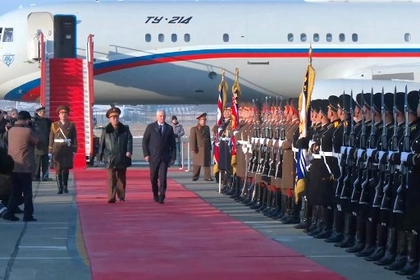Powerful explosions hit the main base of Russian military aviation in Crimea in the early hours of Wednesday and set fires burning for hours, in long-range strikes the Kremlin said were American ATACMS missiles fired by Armed Forces of Ukraine (AFU) gunners.
Local social media followed by regional officials reported more than twenty explosions of varying intensity audible in the vicinity of Belbek airfield beginning shortly before 2 a.m. Moscow time and lasting about ten minutes.
JOIN US ON TELEGRAM
Follow our coverage of the war on the @Kyivpost_official.
Russian officials in the occupation authority in the Kremlin-occupied Crimea in early statements said Ukrainian forces had launched long-range missiles at Belbek airfield but all the Ukrainian weapons were shot down.

Later official announcements, among them by the Moscow-appointed “mayor” of Sevastopol Mikhail Razvozhaev, said US-manufactured ATACMS missiles had been used in the alleged failed strikes. The Russian officials claimed all the ATACMS were intercepted by Russian air defenses, but some of the US-made precision-guided weapons had dispersed cluster munitions, prompting the authorities to warn the public not to touch them.

What if Russia Wins?
Independent analysts and local social media contradicted the Kremlin narrative that a major Ukrainian missile strike against Belbek caused no damage. Comments in Sevastopol and Crimean military chat groups confirmed the launch of air defense missiles but, also, multiple explosions on the ground within the confines of the airfield.
Prior to Russia’s second invasion of Ukraine in February 2022 the Russian Air Force usually based between 20-40 combat fighters and bombers at Belbek full time.
Independent analysts said recordings of major fires burning at the airfield for at least two hours following the strikes, and secondary explosions unconfirmed but reported widely by local residents as the fires burned, could possibly be evidence that the target of the Ukrainian missile strikes were not aircraft, but Belbek airfield’s ammunition bunkers and fuel depots.
According to unconfirmed reports, a second wave of missiles entered the airspace over Belbek and attacked ground targets at 02:35 a.m. In past major missile attacks against the Russian military, Ukrainian air strike planners frequently have staggered weapon launches and routed missiles to targets from multiple directions.

The pro-Ukraine Crimea-focused military monitoring group Krymsky Veter in posts over Wednesday morning said that locals reported massive fires burning at the airfield until near sunrise, with red flames lighting up the horizon. The blaze(s) intensified following the second round of strikes, that source claimed.
Review of imagery from at least two civilian satellite passes over the airfield following the strikes showed three major fires burning in the airfield’s service area south of the main runway, where air unit administrative buildings, aviation fuel depots and bomb bunkers are visible, the independent Russian news platform reported. The fires by morning had been burning for at least three hours, that source said.
The military analysis platform OSINTechnical wrote: “Based on the FIRMS data, Ukraine conducted a successful ATACMS strike overnight on Russia’s Belbek Airbase. Multiple [satellite] passes show a massive fire encompassing the southern flightline, likely fed by burning fuel or munitions.”
FIRMS, or Fire Information for Research Management System, is a NASA-administered worldwide satellite data-gathering project that identifies and tracks the progress of major fires worldwide. A Kyiv Post check of the OSINTechnical claim found fire imagery near Belbek, possibly at three locations.

Russia’s Defense Ministry in a Wednesday morning statement acknowledged the fact of the Ukrainian attack but repeated claims all incoming missiles – purportedly ten in total – were shot down and asserted neither ground installations nor personnel were hit. There was no damage save a minor fire in a field sparked by falling missile debris near the village of Polushko, Crimean authorities claimed.
There was no direct official Ukrainian response. However, in mid-morning, following those Moscow declarations of success, the semi-official Telegram channel Operativny ZSU (Operational Armed Force of Ukraine) published a video seemingly recorded by a military drone patrolling air space near Belbek airfield at night, and the impact of at least six incoming missiles, all of which detonate on the ground. Beyond identifying the recording as probably collected by a military drone monitoring missile strikes on an inhabited location with low mountains in the background, Kyiv Post could not confirm the video’s authenticity.
A caption to the 90+ second video read, in colloquial Ukrainian: “🔥Belbek airfield tonight. According to the Russian Ministry of Defense, 10 ATACMS missiles were shot down over the territory of Crimea. Yeah, right, (all) shot down. Except the one that (vulgar)ed you up.”
After sunrise Razvozhaev’s office published what appeared to be a photograph of two ATACMS cluster munitions lying in a patch of grass and poppy flowers, along with a warning to the general public that the American explosives had scattered to locations around Sevastopol and could be deadly if picked up. It was not possible to geo-locate the photograph independently.

Russian milbloggers widely reported MGM-140 ATACMS missiles had been used in the strikes and identified the cluster munition as an M74 bomblet, a baseball-sized explosive used by US weapons manufacturers for some cluster munitions. Anti-airfield/aircraft versions of ATACMS missiles known to have been delivered to Ukraine can carry close to 1,000 M47 bomblets.
Kyiv’s ambitious Wednesday morning missile strikes aimed at Belbek airfield followed a wave of long-range missile and drone attacks against military targets across the Crimea peninsula two weeks ago. In that series of attacks, the Ukrainians targeted Russian air defenses.
You can also highlight the text and press Ctrl + Enter






